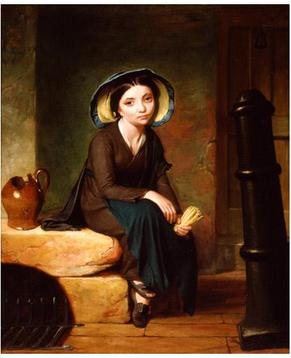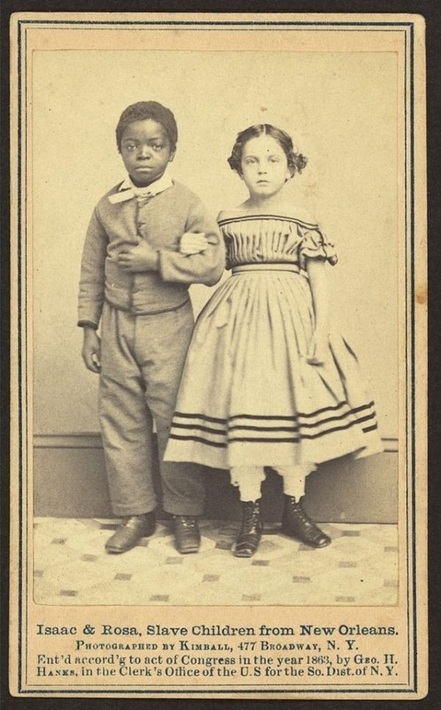 The Match Girl by Flagg, New York Historical Society The Match Girl by Flagg, New York Historical Society Salome Muller, was born in 1809 in Langensoultzbach, Alsace, three years before the first of a series of East Indies volcanic eruptions that would create a disastrous cooling trend with other major environmental changes across Europe and Asia. In Alsace, the air was filled with a haze, and crops planted at the usual time in spring would be frozen over and new ones planted. But by August whatever had survived of the new plantings would be killed by an early frost. Millions suffered and starved. If what was planted did not survive there was no plan B. Children were sent to forage for nuts and berries. Men hunted, but game grew scarce. The year 1816 is known as The Year Without a Summer and it was during the winter of that year that Daniel Muller got together with his wife, Dorothea and their four children, into his brother Henry's kitchen. Henry had a wife, and three children, two girls and one boy; both families gathered around a lithograph of a couple with their children in Missouri, with flowers in their front garden, geese in a yard, and cattle grazing in lush pasture as part of the background. The Muller families were Alsatian shoemakers, and if a decision was made to emigrate to America, then both would go together. A couple more families from the village joined the discussion and their imaginings were to travel to a land of plenty, as a group and to live and prosper in America as independent families living next to each other as they were now except with plenty of game to hunt and fish and crops to eat. They assured themselves of guaranteed employment in The New World. "The men were farmers, locksmiths, shoemakers, and storekeepers. The women were cooks, milliners and midwives. They carried Bibles, food, precious musical instruments and tools of their trades," as they left the village in the spring to travel to where they could embark upon the long ocean voyage to America. The journey was beyond brutal for when the Muller families, along with nearly everyone else from Langensoultzbach, got to Amsterdam, they found themselves to be of the lowest sought cargo of all: immigrants. Shipowners of ill repute were the only persons willing to deal in such a trade as hauling impoverished men, women and children across the Atlantic, all in hope of a new life. The first shipowner, of the dilapidated Rudolph vessel, took the Mullers' money and the specie of the estimated 900 others who were crammed into the Rudolph, waiting for it to sail. But the shipowner was never seen again, as after waiting for days, the family heads, Daniel and Henry, left the anchored ship and entered the city to search for the man who had absconded with the last of their savings. The brothers found to their horror that the supposed shipowner had not only left town with some of the final savings of 900 poor immigrants, but he had never owned the ship to begin with. The original owners had no time nor inclination to clean up the thief's mess because they were in court attempting to reclaim ownership of the vessel, rotted as it may have been. The Muller families along with the other immigrants were all ordered off the ship after five months of living there because the court had finally decided to return the less than grand Rudolph to its original owners and the Mullers were to go back to Amsterdam and be under the care of local governance and charity. The government, due to the overwhelming number of immigrants held up and running ragged through the streets of Amsterdam, offered to pay 30,000 guilders to anyone willing to transport these poor impoverished beings to America. The Mullers were told to go back to Helder; for despite it being winter, a new ship was ready to set sail to America. The New Sea Air, as the latest vessel of wonder was ironically named, was in worse shape than the Rudolph. The Mullers boarded her, but she was not to take them to their dream country. Her mast broke from winter gales and the ship returned to port, shortly after setting sail. A new merchant to the scene, Mr. Krahnstover, agreed to take the tolerant souls to America via New Orleans port, on three different, well conditioned ships, but on the condition that upon arrival in America, the immigrants would be sold as redemptioners. In essence the immigrants had become a form of slave cargo. The names of the ships were: The Emmanuel, the brig, Juffer Johanna, and a brigatine, Johanna Maria. And upon all three ships carrying 1100 people total, one departing after another; rations were scarce. Ventilation within the hull was inadequate. Drinking water went bad. It is astounding any of them survived the voyage. But some did. Though of the Muller family, Daniel's youngest child lasted no more than two weeks out of Helder. And the next day, Dorothea died. The father wrapped up both his wife and son in shoddy canvas sheets and tipped them overboard into the water. Henry Muller's wife died. Every day a different body was given to the sea. Due to hiring of an incompetent crew, whose resume expertise was that of canals and not oceans, a journey that should have lasted two months took at least three to five. There were only provisions for two months. But finally, finally, a mud colored canal appeared to break apart the ocean, it was the Mississippi. At last it was America! The group traveled up the mouth of the river and into the city of New Orleans. But here, the families were broken apart. Redemptioners were cheaper than slaves, with five or six of them being purchasable for the price of one slave. But their servitude would be for a certain number of years, rather than full life as with a slave. So, the maintenance expense, overall, was much less for an indentured servant than a slave. And rarely, if ever, would whole immigrant families be bought together. Husbands, wives, and children were sold separately. The going rate for short term immigrant slaves was 80 dollars for men, 70 for women, 60 for boys and girls are not mentioned. Though, short term, connotes that servitude was not for life. But children could work for 10 years or more depending on the age they are at the time of their sale. The Muller families agreed to stay together but into the third week, it became clear they would be fortunate to find a master to take the father of each head and his children together, much less both families. By this time, a starved Henry Muller with Salome, her sister and brother, were bought, all four, by a farmer in Bayou Sara, a four days sail up the Mississippi. According to a tale later told by a boat crewman, a Dutch man and his three children, set up the Mississippi, but the man died while on the voyage, (perhaps from eating too much after starving for so long) and his son drowned, probably due to suicide. So, two little girls were all that was left of the Henry Muller family. They were left by the boatmen with signs around their necks at the Bayou Sara, a desolate stopping point. Then on a spring morning in 1843 Madame Carl Routt traversed the neighborhoods of New Orleans to visit a friend. On her way she sees a woman, dressed as a slave, with a tignon of bright madras cotton, a course linen dress and a dark kersey shawl. Madame Carl was struck by the woman and thought her to be Dorothea Muller, before she realized herself and decided if the woman, sitting in the sun before her was not Dorothea Muller, then it was likely Salome, her daughter. And so, begins a deeply complicated and convoluted court battle as to the identity of Salome Muller; pitting the German community against the owners, current and past, of the light skinned slave woman. The girl Madam Carl thinks is Salome describes herself as a yellow girl by the name of Mary Miller. By all accounts Salome did appear to be very close in similarity to a quadroon, a person at the time of 1/4 African heritage. But the physical difference between a quadroon and an olive skinned German girl was truly impossible to say. Basically as long as a person had any African ancestry whatsoever, they were considered a slave in the United States unless freed according to law. The German community fought for Mary Miller's freedom, stating she was really Salome Muller. Along the course of the proceeding, Salome, was thought to be also called Sally Miller. According to documentation a Salemia Muller was sold to a Thomas Grayson. Where she ended up after that no one really knows. Various identities were formed on the basis of Salome Muller. Mary Miller, Bridget Wilson, Sally Miller, and Polly Moore among others. The story captivated New Orleans and ruined the reputations of slave owning men. The author claims her to be truly Bridget Wilson the slave. Though, the bibliography index has a Saloma Meller listed, yet there is no Meller mentioned in the book. (The difference could be a matter of pronunciation or translation). So, whoever she was, she certainly withheld the art of captivation. By Sarah Bahl |
Archives
June 2017
Categories
All
|

 RSS Feed
RSS Feed